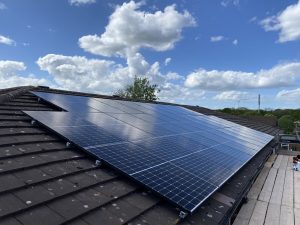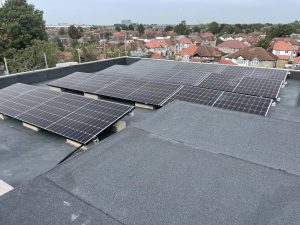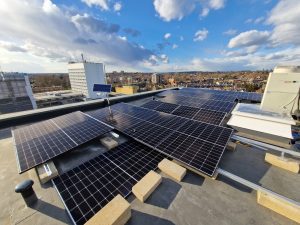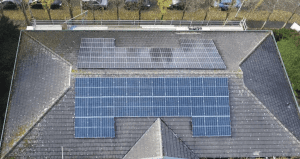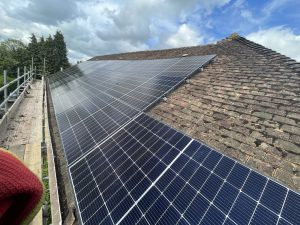From Empty Rooftops to Energy Assets: Solar for Warehouses in the UK

Written By
- Bhavna S4G
Published on
- 01 May 2025
In the face of rising energy costs and increasing environmental concerns, UK warehouses are uniquely positioned to lead the transition to renewable energy. With vast, often underutilised rooftop spaces, warehouses present an untapped opportunity for solar energy generation. This blog explores how converting these empty rooftops into energy assets can benefit warehouse owners, the environment, and the UK’s broader energy goals.
The Untapped Potential of Warehouse Rooftops
Warehouses across the UK possess expansive flat or slightly sloped roofs, making them ideal candidates for solar panel installations. These large surfaces are often free from obstructions, allowing for optimal solar coverage. Unlike residential rooftops, warehouses provide scale, offering the potential for substantial electricity generation with minimal land impact.
Benefits of Solar Energy for Warehouses
1. Reduced Operational Costs
Electricity is a major overhead for warehouse operations, especially for lighting, heating, ventilation, and automated systems. Generating electricity on-site allows businesses to reduce dependency on external suppliers and potentially cut long-term operational expenses.
2. Energy Security and Independence
Solar systems provide a level of autonomy from grid fluctuations. For warehouses located in areas with unstable energy supply or facing time-of-use tariffs, solar installations can offer more predictable and controlled energy access.
3. Sustainability and ESG Alignment
As companies are increasingly measured by their Environmental, Social, and Governance (ESG) performance, solar power is a strategic move. It demonstrates a tangible commitment to sustainability, which can boost brand reputation and satisfy stakeholder expectations.
4. Boosted Property Appeal
Warehouses with renewable energy systems are more attractive to prospective tenants and buyers. A solar-equipped facility often has a higher Energy Performance Certificate (EPC) rating, enhancing both rental income potential and resale value.
5. Contributing to National Goals
The UK government has set ambitious targets to reach net-zero carbon emissions. Warehouses adopting solar play a key role in contributing to national sustainability goals and reducing the burden on the national grid.
Step-by-Step Guide to Solar Implementation for Warehouses
Energy Audit – Evaluate your current energy usage to determine the right system size.
Site Survey – Professional inspection of the roof and surrounding conditions.
System Design – Create a tailored layout optimised for sunlight capture and business needs.
Financing Assessment – Select the best financial model based on business goals.
Installation – Engage certified professionals for system setup and safety compliance.
Monitoring & Maintenance – Use monitoring tools and regular maintenance to maximise performance.
Long-Term Maintenance and Monitoring
Solar systems are low-maintenance and built to last. Warehouses can benefit from periodic inspections to ensure panels are clean, free from damage, and functioning optimally. Monitoring software helps track performance metrics and maintain peak efficiency.
Also Read: Understanding Solar Panel Warranties: What Consumers Should Know
FAQ: Solar for Warehouses in the UK
Q1: Do I need planning permission to install solar panels on my warehouse?
In most cases, installations fall under permitted development. However, very large systems or installations in protected areas may require planning consent.
Q2: How do I know if my roof is suitable for solar?
A solar installer will assess the age, structure, orientation, and shading of your roof to determine feasibility.
Q3: Can I still use electricity from the grid after installing solar?
Yes. Your building can draw from the grid when solar production is low or during peak demand times.
Q4: What happens to the excess energy generated?
Depending on your system setup, surplus electricity can be exported to the grid or stored in a battery for later use.
Q5: Is battery storage necessary for warehouse solar systems?
Not always. Battery storage is optional and mainly useful for increasing energy independence or managing peak usage.
Q6: How long does it take to install solar panels on a warehouse?
The timeline varies based on system size and roof complexity but is typically completed within a few weeks after approvals.
Q7: Can tenants install solar panels on leased warehouse roofs?
It depends on the lease terms. Open communication between landlords and tenants is essential, and agreements should be clearly defined.
Q8: How can I finance a commercial solar system?
Options include loans, leases, and PPAs that allow you to install solar with little to no upfront cost.
Q9: Are solar panels effective in the UK’s climate?
Yes. Solar panels work even on cloudy days and are well-suited for the UK climate.
Q10: What is the lifespan of a commercial solar system?
Solar panels typically last 25 years or more, with inverters and other components having varying lifespans.
Looking to turn your warehouse roof into a powerful energy asset?
Get in touch with Solar4Good today and explore how solar can save costs, boost sustainability, and deliver long-term energy resilience for your business.


